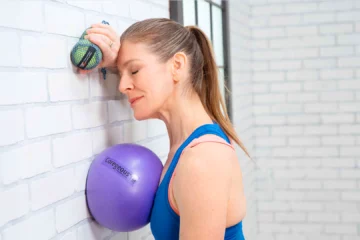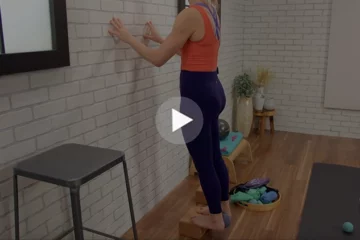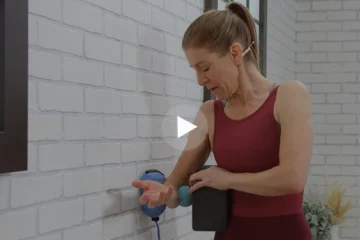
I’m a couple weeks away from “D” day (Delivery day) and physically pregnancy has been a gift. First trimester aside, I am still teaching multiple classes per week, I can walk for several miles, and I sit on the floor to eat meals and am able to get up with the same level of ease as before pregnancy.
But there are modifications that I’ve made in order to account for my ever growing “bump.” Also, in the first trimester I needed much more rest than usual. So I scaled back on commitments and tapped into some deeply constructive rest methods–specifically, breathing techniques that work the body’s main respiratory muscle, the diaphragm, to help boost proprioception and induce constructive rest.
Anatomy alert! The diaphragm is the key respiratory muscle, and is in charge of approximately 75% of our breathing capabilities (the external intercostal muscles contribute to about 25% of respiration). The diaphragm is a broad, dome-like shaped muscle that attaches to the ribs and lumbar spine. During inhalation the muscle fibers contract and the dome like shape descends as the ribs widen. Upon exhalation, the muscle ascends and the ribs narrow and this process is usually quite visible.

In Yoga Tune Up® we explore the following three abodes of breath:
- Clavicular breath is when the chest moves quite noticeably upon inhalation. Observing people during times of stress (i.e. hunched shoulders, shallow breath, chest moving but not much else) allows us to observe clavicular breath. Worth noting is that this form of breath has become the standard way of breathing, at the expense of other abodes.
- The second abode is known as the thoracic breath, which recruits the diaphragm a little more and you can observe movement of the rib cage is it moves right to left. This breath is particularly helpful during poses where there is little room for full belly breaths (think child’s pose).
- Abdominal breath is the most relaxing, and uses the diaphragm’s fuller range of motion as the muscle plunges deeper down. One way to recruit this type of breath is to recall to mind a time when you were in bed just before falling asleep and your belly was so soft, no need for “sucking in” or bracing or even shaping the breath. Try abdominal abode of breath with me by watching this belly breath video.
Lying down (Savasana) legs and arms outstretched. Place one hand on your belly and the other rest it easily on your ribs so that the shoulders can relax. Spend just a moment settling into this rest position, then intentionally shape the direction of your breath by inhaling so that your belly expands first, ascending toward the ceiling. Allow this breath to “fill up” so that you can feel the motion of your ribs move under your other hand. And exhale. Continue at your own pace for five more breaths.
During the abdominal abode of breath our bellies are completely relaxed and have the ability to inflate with each exhale…usually. But in practice, many students tend to tighten their bellies and widen their ribcage on each inhale. We have misplaced our ability to move our midsection naturally with our breath.
So do try practicing the abdominal abode of breath to help reset and deeply connect to conscious relaxation. Of this comes effortlessly to you, congrats! For hundreds of students I have worked with, this breath escapes them. Among these are athletes, people who are physically “fit” etc. So take a minute, try this breath reset and, if it seems to elude you, keep practicing. If it comes easily, try practicing it while standing, then while walking and going about your everyday activities, observing when you start to tighten or “suck in” your belly again.
Remember that whatever physical situation you are facing right now, there are some relevant tools to help you in your process. The belly breath and down regulation practice during my pregnancy has helped to keep me in tune. Enjoy practicing with your own natural respiration!












I love belly breathing. I notice I have to consciously focus and visualize the breath flowing into my stomach region to fully benefit. It is a great challenge when you try to stand upright and have ‘good posture,’ and a toned core and also breathe more into that area all at the same time. I am almost always cued to un pop my ribs and to move shoulders away from ears!
Belly breath is a great way to activate the parasympathetic nervous system. The point to emphasize is the relaxation of the belly. It is difficult for so many of us to release the ‘suck it in’ of daily life. When these students are instructed to perform belly breath, I see many of them using muscular effort to bring their breath deeper and inflate their bellies. This seems to have an up regulating effect. Relaxing the belly is the toughest part!
I start almost every class with the students on their backs, giving them some time to settle and tune in to their bodies. The floor provides support and feedback as their bodies begin to soften into it. I gradually guide then through belly breathing. I have always preferred to begin my practice this way and have found it to be the most effective path to down regulate, which we all need (especially here in Washington DC!).
Yes, breathing is so important for all parts of life, and pregnancy is no exception! It was also so useful for me to be able to work with the breath in both labor and delivery. It made what any normal person would describe as intense pain into a meditation on the breath and its relationship to the nervous system and pain management. So in addition to all the benefits of practicing breathing as a pregnant woman, there’s the added benefit of knowing you are preparing for birthing the baby!
I have loved cueing the abdominal-thoracic breath at the start of every class I have taught since taking the Level 1 Yoga Tune Up Training. Bring students into this deep awareness of the inner movement of the breath and the ability to change our shape from breath alone gives such a grounding to the beginning sensations of practice and you can just feel the whole room fully drop in. The more I learn about the diaphragm, the more I am convinced we really need to start every practice there -and that we owe it to our students to educate them on how it all works.
Thank you for talking about taking time for conscious relaxation before trying to work the abdominal breath. It is difficult for anyone to jump into belly breathing after hours (years?) of holding in the stomach.
I took my first Yoga Tune Up Self Care class last year and one of the first things we did was lay in our backs with our knees bent and one hand in our heart and the other in our belly. We were told to inhale and allow the belly to balloon. I tried several times to do this and my belly would not expand or balloon. I felt like I was doing kore of a core workout by engaging my belly to try to push it out. It’s then that I learned that for the last several years I was so stressed at my job that I was not fully breathing. I was taking short inhales and exhales with only the top part of my chest. I know I am not alone here when it comes to being in a constant state of acute stress response or the fight or flight response. Our work lives and personal lives are busier than ever and keeps us in this constant state. It took me about a year to learn how to relax my belly and take full breaths allowing my diaphragm to lower and my belly to balloon. It’s funny that after the fact, my friend who recently had a baby said she was watching her son breathing while he slept and she said to me, “When we breath, our bellies are suppose to get bigger. I figured that out by watching Z sleep.” It’s amazing what we can learn by watching a baby and how our bodies were created to move.
This is such a good reminder of the basics of breathing!! Thx! 😉
From the age of 3, I started sports. I continued to 21 when I started yoga and other physical activities. At times very intensive activity and mainly with compensating the breath for performance or esthethics. Life began to deteriate until I realized the subtle was more profound then the obvious. Its now at 35 Im realizing what is the point of movement if there is not proper breath. You can be active all you want but the breath tranforms the work and life. This article further reinforced its importance and profound capabilities to transform life.
Thank you Christina for this. As breath is quite automatic, people tend to forget that with intention breath can re-energize you, down-regulate you, bring you to the present moment, as well as boosts proprioception. It is a great reminder that we have the ability to control our breath which in hand can control our being. Breath is powerful.
Thank you for sharing. The diaphragm is largely ignore in many movement classes, that is why I love Yoga Tune Up because it places so much focus on breath and strengthening the diaphragm. I find that my breath is so much deeper and am able to retain my breath longer after learning the combined clavicular, thoracic, and abdominal breath. It’s simple but life changing.
Learning the three abodes of breath is life-changing; I can also see how necessary it is for such a life changing event of having a child! Amazing that breath is something very automatic yet we have the ability to control it. We all have the power to heighten our moods or relax them. Our breath is our power.
Très pertinent, nous oublions tellement souvent l’importance des petites gestes tout en simplicité, tel que la respiration abdominale, comme étant un calmant naturel qui stimule positivement le diaphragme! Et oui, nous devrions l’appliquer à d’autres moments que le savasana!
I also found it difficult to breath through the stomach vs breathing through the ribs. This is a helpful way to learn and feel the difference. I find it very helpful to understand and can both literally feel and mentally notice the differences!!
Excellent breakdown of the diaphragm, its relation to breath and relaxation. As mentioned, even as an athlete, it took a long time to understand how to really expand my stomach. I find it particularly helpful to place the hands on the stomach for feedback. Alternatively, the floor also helps! Looking forward to your future posts.